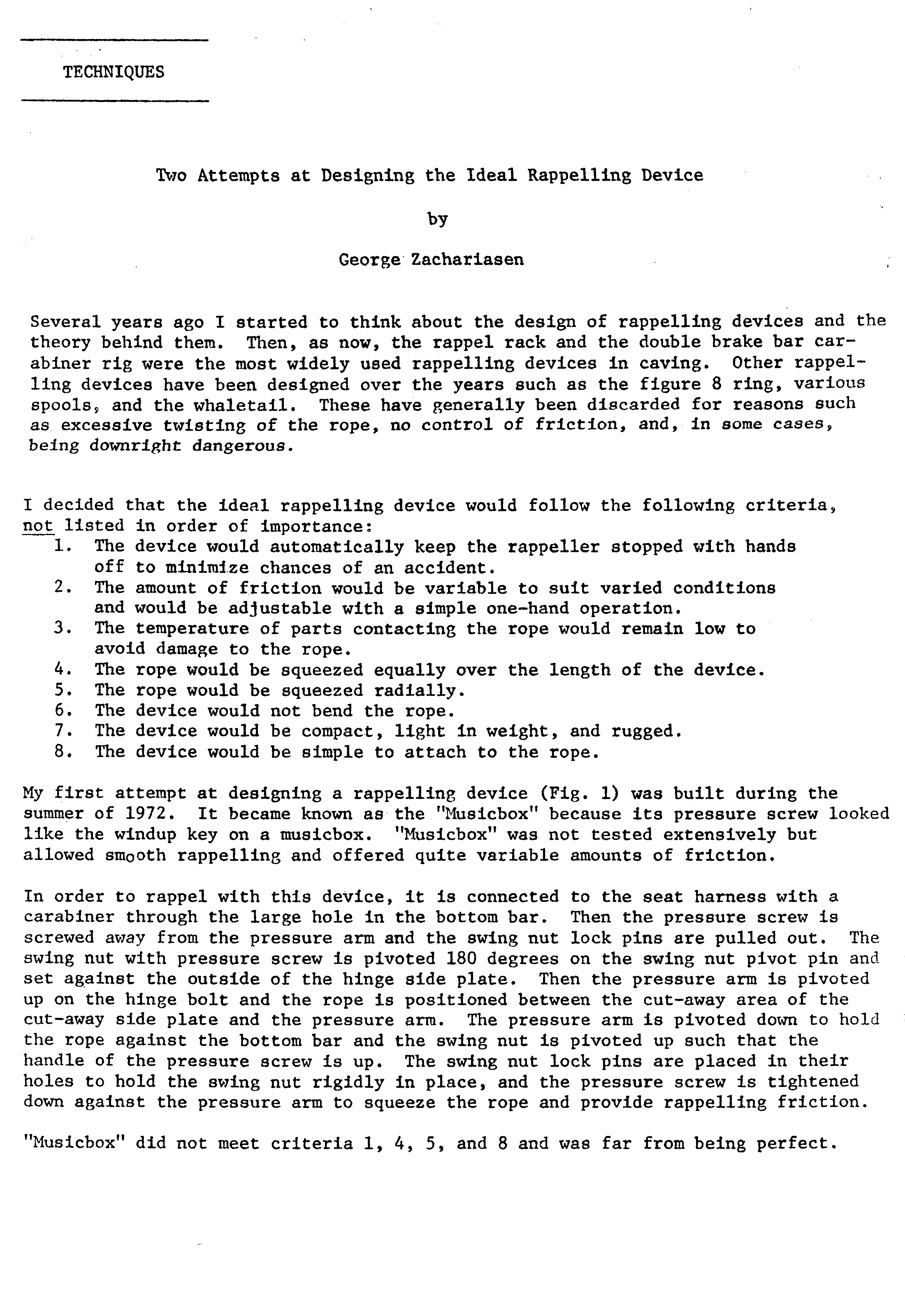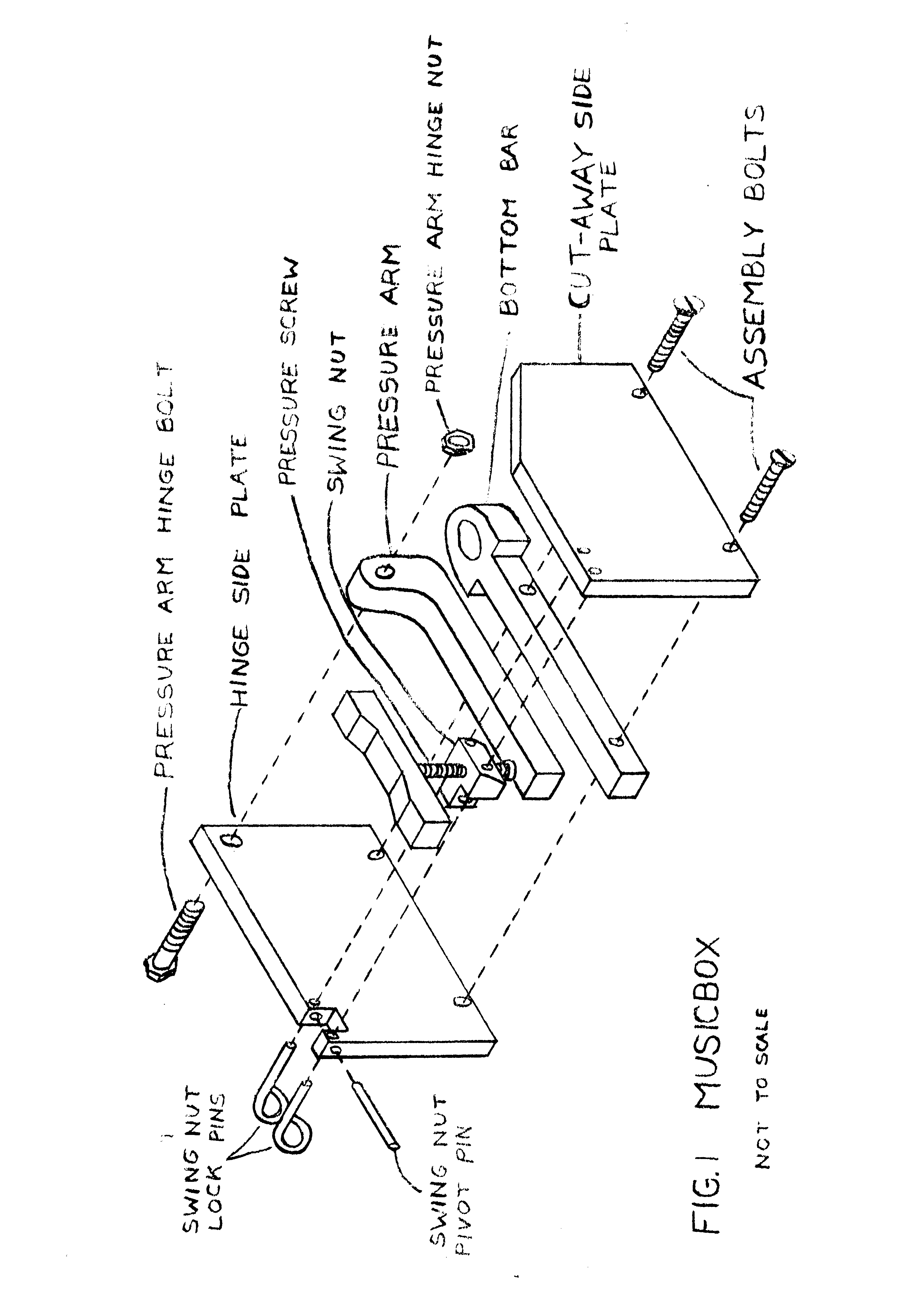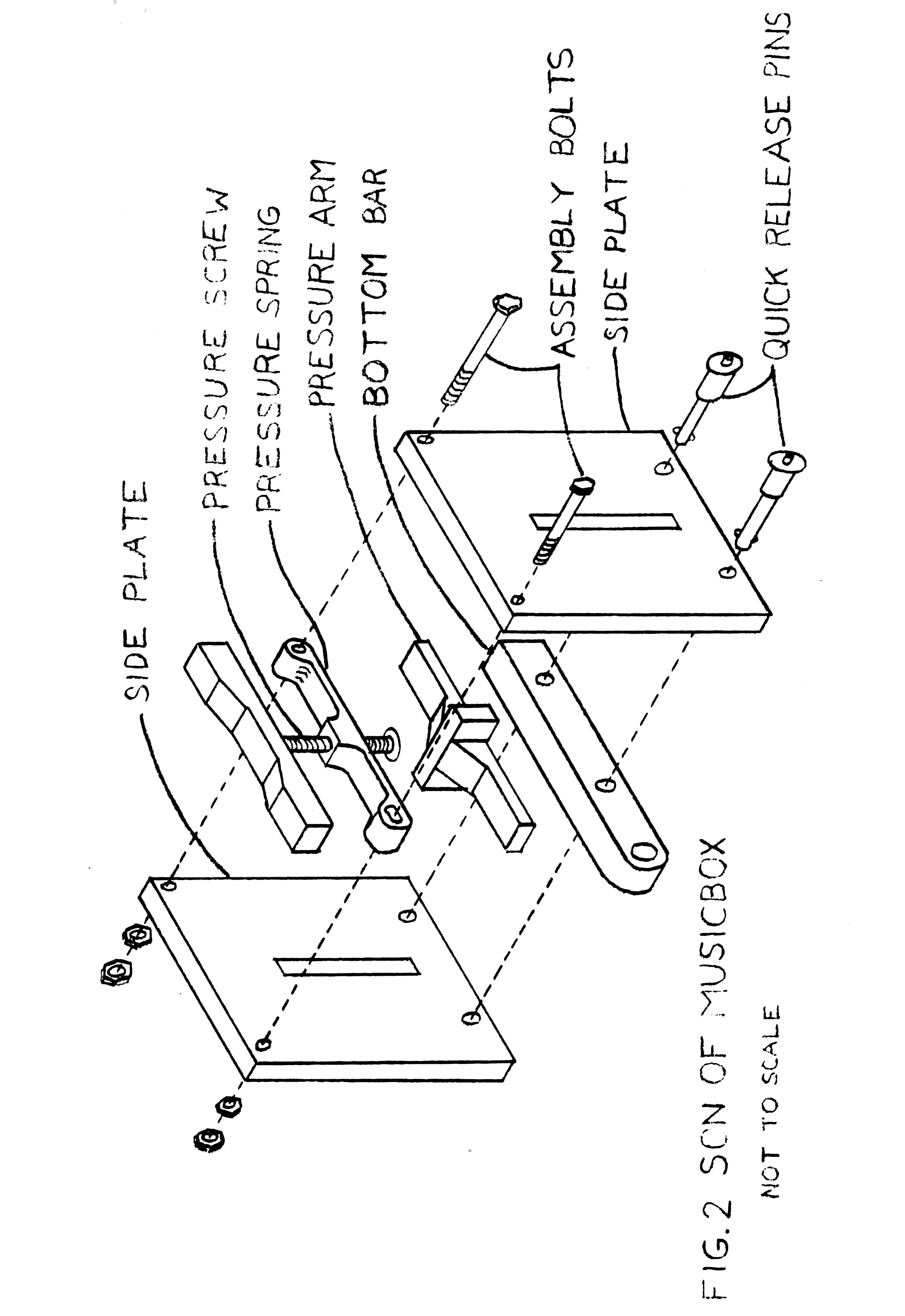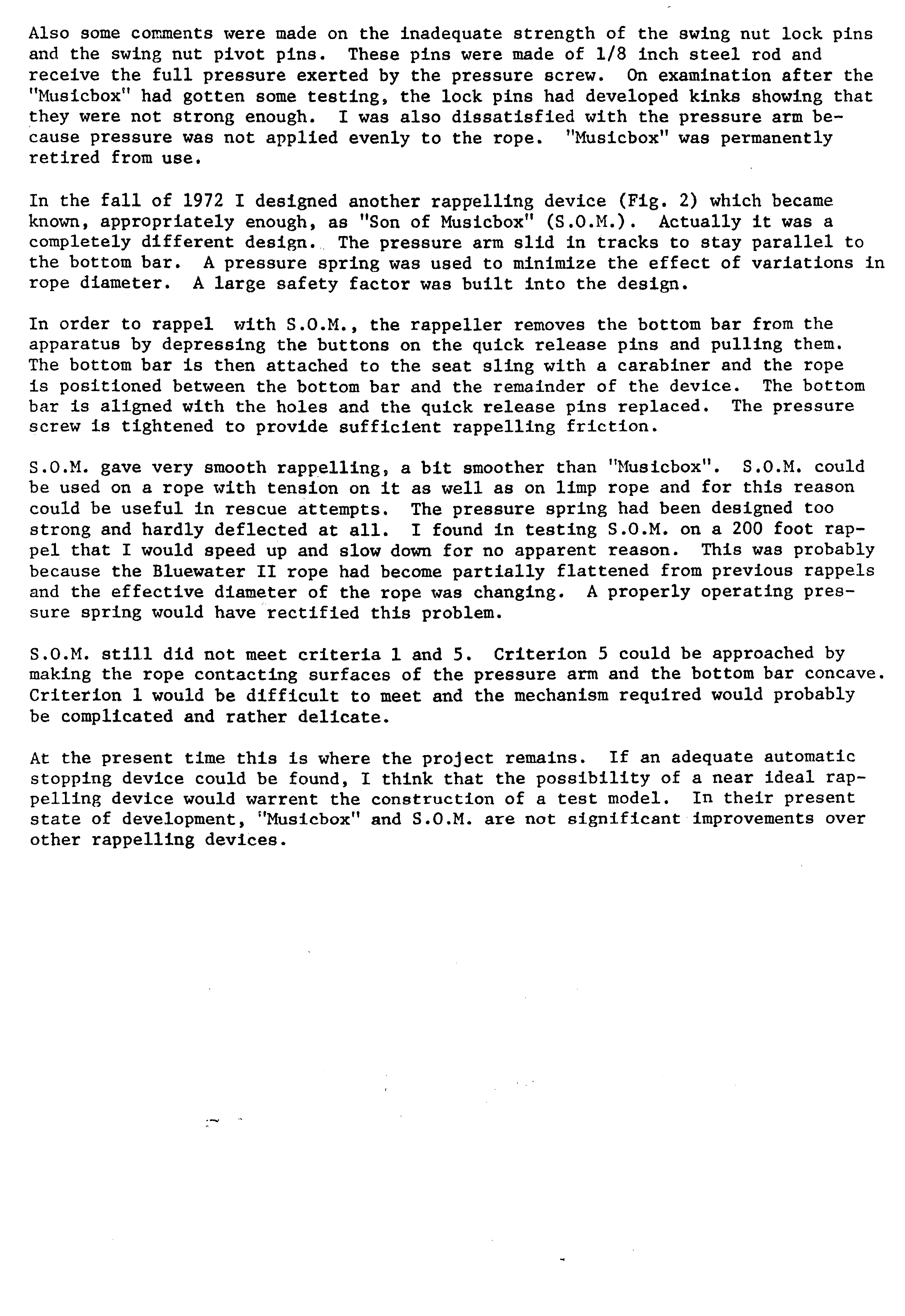Overview
Squeeze brakes once generated a lot if interest in the caving
community because they have a large contact area and do not bend
the rope, and therefore appear to be appealing for long drops.
Unfortunately, a simple squeeze brake does not provide adequate
control because the friction is quite sensitive to the separation
between the plates, and unlike snubbing, increasing the tension
below the device does not effectively increase friction; instead,
it decreases it somewhat. Following some severe accidents, interest in squeeze brakes declined dramatically.
[ Top
| Son of Musicbox
| Return to Squeeze Brakes
]
Storrick – Zachariasen Musicbox
(#3252)
Technical Details
I made this Musicbox in 2023.
My Musicbox is 222 mm. tall, 80 mm. wide, 60 mm. thick, and weighs 622 g.
My Musicbox has 3/8" (9.5 mm.) 6061 aluminum front and back plates connected by a spine plate of the same thickness and material. A swinging pressure arm fits between the plates. A pivoting block holds a pressure screw and wing nut. Two 1/8" (3.2 mm) pins hold the block in the closed position. Turning the nut forces the screw against the pressure plate, forcing it against the rope to increase friction.
I stamped my Musicbox with my logo.
Comments
My Musicbox is a copy of one that on George Zachariasen’s built in the summer of 1972 and demonstrated it at the 1972 N.S.S. Convention. George published his design in 1972[1]. He later donated his Musicbox to the N.S.S. Museum, where I photographed it in 2022. I scaled dimensions for my version from those photographs.
George wrote,
I decided that the ideal rappelling device would follow the following criteria, not listed in order of importance:
- The device would automatically keep the rappeller stopped with hands off to minimize chances of an accident.
- The amount of friction would be variable to suit varied conditions and would be adjustable with a simple one-hand operation.
- The temperature of parts contacting the rope would remain low to avoid damage to the rope
- The rope would be squeezed equally over the length of the device.
- The rope would be squeezed radially.
- The device would not bend the rope.
- The device would be compact, light in weight, and rugged.
- The device would be simple to attach to the rope.
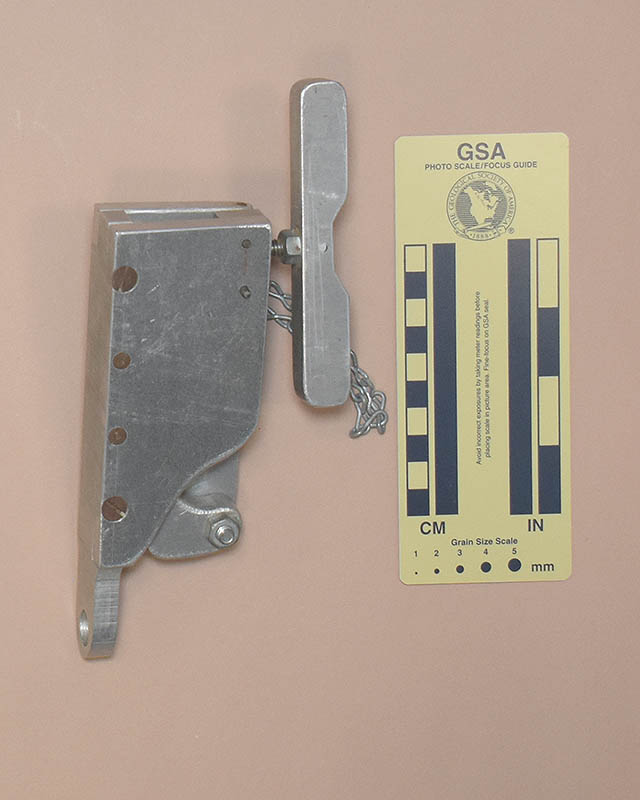 George built the original Musicbox (shown at right) in the summer of 1972 and demonstrated it at the 1972 N.S.S. Convention. When he tested the Musicbox, he noticed that the swing nut lock and pivot pins were not strong enough. My copy shares this weakness, and I do not fully trust it. George retired his Musicbox, writing
George built the original Musicbox (shown at right) in the summer of 1972 and demonstrated it at the 1972 N.S.S. Convention. When he tested the Musicbox, he noticed that the swing nut lock and pivot pins were not strong enough. My copy shares this weakness, and I do not fully trust it. George retired his Musicbox, writing
"Musicbox" did not meet criteria 1, 4, 5, and 8 and was far from being perfect Also some comments were made on the inadequate strength of the swing nut lock pins and the swing nut pivot pins. These pins were made of 1/8 inch steel rod and receive the full pressure exerted by the pressure screw. On examination after the "Musicbox" had gotten some testing, the lock pins had developed kinks showing that they were not strong enough. I was also dissatisfied with the pressure arm because pressure was not applied evenly to the rope. "Musicbox" was permanently retired from use.
Most rappel devices increase friction when a braking force is provided below – that much is obvious from the snubbing formula. Squeeze brakes do not; if anything, friction reduces slightly. Experience shows that turning a pressure screw is not fast enough to control one’s descent speed. There have been severe accidents because of this. For your own safety, do not rappel on a Musicbox.
|
 |
Warning:
The swing nut lock pins and the swing nut pivot pins
are not strong enough TO PROVIDE AN ADEQUATE SAFETY MARGIN |
 |
|
|
 |
Warning:
The Musicbox' friction can vary quickly, widely
and unpredictably,leading to COMPLETE loss of control. |
 |
|
--------
[1] George Zachariasen, 1974. Two Attempts at Designing the Ideal Rappelling Device. The Wisconsin Speleologist, XIII(2), Wisconsin Speleological Society, Madison, Wisconsin.
[ Top
| Musicbox
| Return to Squeeze Brakes
]
Storrick – Zachariasen Son of Musicbox
(#3251)
Technical Details
I made this Son of Musicbox in 2023.
My Son of Musicbox is 159 mm. tall, 124 mm. wide, 70 mm. thick, and weighs 1113 g.
My Musicbox has 3/8" (9.5 mm.) 6061 aluminum front and back plates with a sliding pressure plate between. A removable pressure block is held in place by two QR pins. A pressure spring holds a pressure screw and wing nut. Turning the nut forces the screw against the pressure plate, forcing it against the rope to increase friction.
I stamped my Son of Musicbox with my logo.
Comments
My Musicbox is a copy of one that on George Zachariasen’s built in the summer of 1972 and demonstrated it at the 1972 N.S.S. Convention. George published his design in 1972[1]. He later donated his Musicbox to the N.S.S. Museum, where I photographed it in 2022. I scaled dimensions for my version from those photographs.
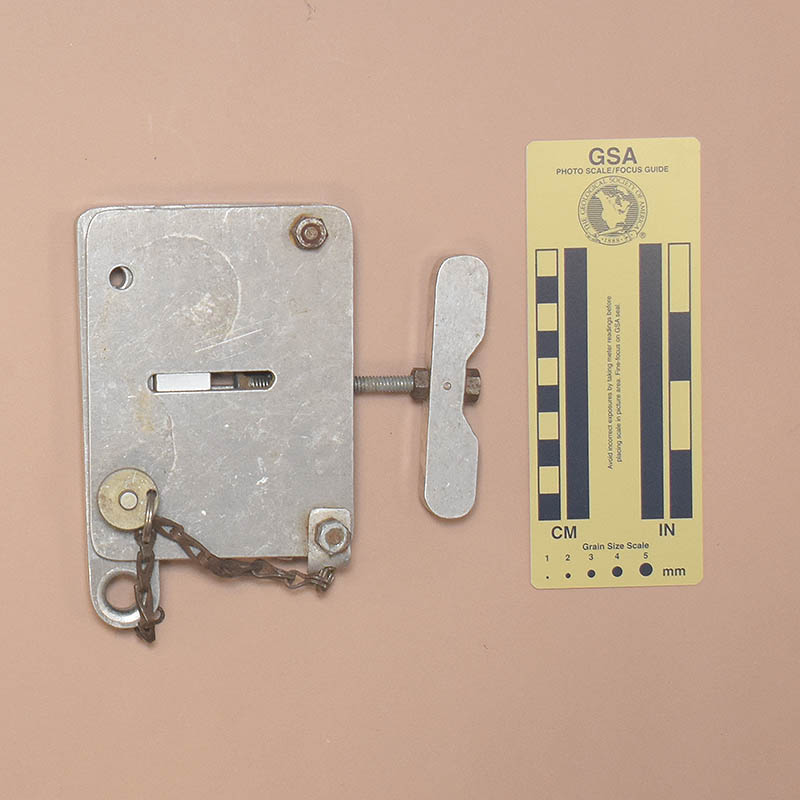 After retiring the Musicbox, George made the Son of Musicbox (S.O.M., shown at right) in the fall of 1972. The S.O.M. had a pressure screw like the one on the Musicbox, but it was mounted on a pressure spring and pressed against a sliding pressure plate. George’s idea was that the pressure spring would minimize the effect of changes in rope diameter, but his spring was too strong and barely deflected. My copy’s spring is also too strong, and I fear that weakening it enough to deflect properly would also weaken it enough to be dangerous.
After retiring the Musicbox, George made the Son of Musicbox (S.O.M., shown at right) in the fall of 1972. The S.O.M. had a pressure screw like the one on the Musicbox, but it was mounted on a pressure spring and pressed against a sliding pressure plate. George’s idea was that the pressure spring would minimize the effect of changes in rope diameter, but his spring was too strong and barely deflected. My copy’s spring is also too strong, and I fear that weakening it enough to deflect properly would also weaken it enough to be dangerous.
George found that the S.O.M. gave a smoother rappel than the Musicbox, but that he “would speed up and slow down for no apparent reason.” This was particularly evident when used on kernmantle rope. George concluded,
S.O.M. still did not meet criteria 1 and 5 [see above]. Criterion 5 could be approached by making the rope contacting surfaces of the pressure arm and the bottom bar concave. Criterion 1 would be difficult to meet and the mechanism required would probably be complicated and rather delicate. "Musicbox" and S.O.M. are not significant improvements over other rappelling devices.
Most rappel devices increase friction when a braking force is provided below – that much is obvious from the snubbing formula. Squeeze brakes do not; if anything, friction reduces slightly.
Experience shows that turning a pressure screw is not fast enough to control one’s descent speed. There have been severe accidents with other squeeze brakes because of this. For your own safety, do not rappel on a Son of Musicbox.
|
 |
Warning:
The Musicbox' friction can vary quickly, widely
and unpredictably,leading to COMPLETE loss of control. |
 |
|
--------
[1] George Zachariasen, 1974. Two Attempts at Designing the Ideal Rappelling Device. The Wisconsin Speleologist, XIII(2), Wisconsin Speleological Society, Madison, Wisconsin.
[ Top
| Musicbox
| Son of Musicbox
]



